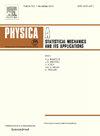Evolutionary dynamics of multiplayer public goods game with the Wright-Fisher process
IF 2.8
3区 物理与天体物理
Q2 PHYSICS, MULTIDISCIPLINARY
Physica A: Statistical Mechanics and its Applications
Pub Date : 2025-02-06
DOI:10.1016/j.physa.2025.130428
引用次数: 0
Abstract
A public goods game (PGG) is a classical evolutionary dynamic model frequently used to explore group interaction and is widely used to explain the emergence and maintenance of cooperation among selfish individuals. This work attempts to study the dynamics of cooperation in a multiplayer PGG that is based on the Wright-Fisher process (WFP). Firstly, a general game -- multiplayer with two-strategy model based on the WFP -- is established to solve the fixation probability of the strategy and to give its natural properties. Then, the multiplayer PGG model with cooperation and defection strategies, based on the WFP, is established, and the fixation probabilities of strategies are solved. In addition, the natural properties of fixation probability are obtained, and the effect of game parameters on the evolution dynamics of cooperation strategy is received. The results show that a turning point of the return coefficient does exist. When the interest factor is greater than the turning point, the cooperative strategy is more likely to occupy the entire population and is an evolutionarily stable strategy (ESSN); the fixation probability of the cooperative strategy also increases in line with the increases in cost and choice intensity. Moreover, the fixation probability of the cooperative strategy increases in line with the increase in the interest factor, and decreases in line with the increase in the number of individuals playing the game and population size. The research in this paper will provide more insights into the evolution of cooperation in a multiplayer PGG.
求助全文
约1分钟内获得全文
求助全文
来源期刊
CiteScore
7.20
自引率
9.10%
发文量
852
审稿时长
6.6 months
期刊介绍:
Physica A: Statistical Mechanics and its Applications
Recognized by the European Physical Society
Physica A publishes research in the field of statistical mechanics and its applications.
Statistical mechanics sets out to explain the behaviour of macroscopic systems by studying the statistical properties of their microscopic constituents.
Applications of the techniques of statistical mechanics are widespread, and include: applications to physical systems such as solids, liquids and gases; applications to chemical and biological systems (colloids, interfaces, complex fluids, polymers and biopolymers, cell physics); and other interdisciplinary applications to for instance biological, economical and sociological systems.

 求助内容:
求助内容: 应助结果提醒方式:
应助结果提醒方式:


